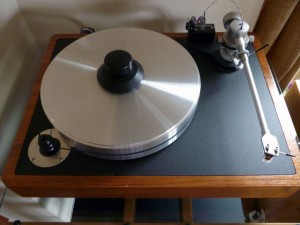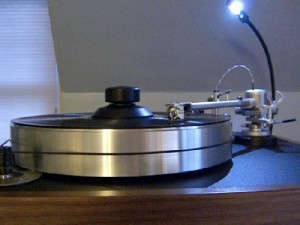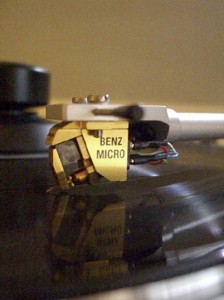Specifications
- Wow and flutter: Less than .02% Rumble: Greater than 80db down
- Speed accuracy: Within .1%
- Platter runout: +/- .001 inch
- Dimensions: 20.75″ W x 15.75″ D x 10″ H (Including tonearm wire loop)
- Tonearm: VPI JMW 10.5 SE (pre-installed on turntable)
- Weight: 48 pounds (net)
- Price: $2,500
- Manufacturer: VPI Industries, Inc., 77 Cliffwood Avenue, #3B, Cliffwood, NJ 07721
Part one of my review of the VPI Classic turntable (November issue) focused on the physical characteristics of this turntable, and on the steps I took to set it up. Over the past couple of months I’ve worked on optimizing the setup of the turntable and have been listening to the thing incessantly. This part of the review will focus on how the Classic sounds.
I installed the turntable on a VTI BL-series audio rack. VTI makes a series of racks at eminently affordable prices, and I’ve been very pleased with the stability and configurability of this rack. The rack is made of steel with MDT shelves, and its spikes couple nicely to the (very bouncy) hardwood floors of my listening room. Acting on the recommendations of others that mass-loading is the way to go with this turntable, I placed the Classic on a 2 1/4 inch thick maple cutting board (a Boos Block, obtained from amazon.com) on the top shelf of the rack.
Those of you who read part one of the review will recall that the standard counterweight supplied with my Classic was too heavy for my Grado Sonata cartridge; VPI provided a lighter counterweight (Harry Weisfeld notes that VPI makes five different weights for the JMW 10.5 arm); this proved to be ideal. It was doubly useful to have the lighter weight, since Garth Leerer of Musical Surroundings provided me with a Benz Micro Glider SL (low output) for future review. This cartridge weighs about the same as the Sonata. Garth also provided me with a Musical Surroundings Nova Phonomena phono stage; initial listening was done with the Sonata/Nova Phonomena combination, but I settled on the Glider/Nova Phonomena pairing for critical listening (using the phono preamp’s battery-powered mode). I used Ultimate Cables silver and copper interconnects between the turntable, phono stage and preamplifier, and used the supplied VPI plastic screw-on record clamp.
While the Classic features an anti-skate mechanism for the tonearm (based on weights and thread), Harry Weisfeld feels that the tonearm cable along provides adequate antiskating force. I listed to the turntable both with and without the antiskating device attached, and did not hear a meaningful difference, so I left the device disengaged. Weisfeld also suggests not using any form of platter mat, and simply clamping the LP to the metal platter. I followed his advice; owners would do well to ensure that the platter is kept scrupulously clean, lest any grit be ground into one’s LPs.
For comparison, I listened also to my reference turntable for the past several years: A Linn LP-12 with the Ittok LVIII tonearm. Over the years, I’ve upgraded this turntable with a number of enhancements that are affordable alternatives to Linn’s own upgrades. Specifically, I replaced the Valhalla inboard power supply with the Mose/Hercules II outboard power supply (as an alternative to Linn’s own Lingo power supply) and I replaced the standard LP12 subchassis and armboard with the Cetech carbon fiber and aluminum honeycomb equivalents as an alternative to the Keel one piece subchassis/armboard. I also replaced the aged standard issue interconnect with one from Ultimate Cables.
In my listening room, before I even had an opportunity to listen critically, a key differentiator arose between the Classic and the LP12: On the suspended wooden floors, I have always had to tiptoe around for fear of setting the Linn’s suspension gyrating and the stylus skipping across the LP. The mass loaded Classic was much less susceptible to footfalls, a real bonus for me.
While initially a bit skeptical, I have come to appreciate the Classic’s record clamp. Though it does require the owner to add another step to the LP listening process, it does a marvelous job of making the vinyl one with the massive platter. It also renders playable some badly warped albums that simply won’t play on my LP12.
Listening
First things first: Whether listening to the Classic with either the Sonata or the Glider, I was first struck by the Classic’s honesty. By this I mean the ability of the turntable to reproduce what is in the grooves without adding additional color, or artifacts, to the sound. I did not sense that this was a turntable that had its own “sound”. By contrast, I’ve always felt that my LP12 “interpreted” LPs in its own way. (Not that I’m complaining; the reason that the Linn has been my reference for so long is due to the fact that I find its interpretation—particularly with the Grado cartridge—so attractive.) Nonetheless, I feel that it’s fair to say that the VPI will provide a more honest picture of what your LP is able to offer.
The honesty extends across the frequency spectrum, though the first thing that impressed me was the Classic’s astonishing control of low frequency material. Whether the thundering organ in Saint-Saens’ “Organ” Symphony (Classic Records RCA Living Stereo reissue with Charles Munch and the Boston Symphony Orchestra), the explosion of Art Blakey’s drums at the beginning of “A Night in Tunisia” (Music Matters Blue Note 45rpm test pressing), or Charlie Haden’s acoustic bass line in The Private Collection (The Naim Label 3 LP set) the Classic transmitted an unrelenting solidity to the bass notes, a sense of controlled power unmatched by any sub-$10,000 turntable that I’ve heard.
At the other end of the spectrum, the highest frequencies are reproduced with both delicacy and dynamism. I listen to a great deal of acoustic jazz, and getting the sound of cymbals (especially brushed cymbals) right is not easy. It’s not unusual for brushed cymbals to sound like undifferentiated “whishing”; listening to the Vince Guaraldi Trio’s A Charlie Brown Christmas (Analogue Productions’ 45rpm Fantasy reissue) on the Classic I was able to easily differentiate between the sounds of different cymbals.The midrange is an zone in which I’ve always felt that the LP12, particularly matched with the Grado Sonata, is a star. Particularly with female voices, the LP12/Sonata combination drips with honey. I was thus keenly interested in comparing the Classic to this oh-so-important frequency range, where “the music lives”. I would not unreservedly use the word “lush” to describe the Classic’s midrange.
As noted above, the turntable is, above all, honest. It neither adds nor subtracts to what is on the LP and presents a balanced set of skills. If the recording is lush (Dusty Springfield’s “The Look of Love” from the Casino Royale Soundtrack, for example), the Classic renders lush. By contrast, Joanna Newsom’s childlike, warbling voice on Ys (Drag City Records) is anything but lush, and the Classic renders it just the way it should sound: Dry and as if rubbed with rosin. I’m usually disappointed by the sound quality on live albums, but Alison Krauss and Union Station’s Live (MFSL) is an important exception to the rule. To dispel any suggestion that the Classic adds a clinical cast to wellrecorded vocals, just listen to “When You Say Nothing at All”. Krauss’s soaring voice just sounds so right. Moments like this provide the justification for spending money on this hobby.
Nor does the Classic excel only at female voices. From the same AKUS live album, Dan Tyminksi’s voice on “I Am a Man of Constant Sorrow” is reproduced deftly, with just the right touch of hoarseness/breathiness around the edges. Jon Pousette-Dart’s solo acoustic performance (available on Peter Ledermann’s Direct Grace Records label, and recorded direct-to-disc at 45rpm) is revelatory: Pousette-Dart’s voice has mellowed since the Pousette-Dart Band’s 1970s heyday, and the Classic/Glider combination beautifully captures the edge to his voice on this closely-miked production. It also renders Pousette-Dart’s metal-stringed acoustic guitar in an astonishingly realistic way. Virtuoso guitarist Charlie Byrd played primarily on guitars with nylon strings. On his eponymous 1977 direct to disc 45rpm release on Crystal Clear Records, the first track “Moliendo Café” showcases his playing skills in a flamenco-like track. The Classic presented Byrd’s guitar work in a clearly defined, articulate way, despite substantial backup instrumentation.
The Classic had no problems resolving complex passages, whether orchestral or choral. In the former case, the Classic rendered the explosive finale of Mahler’s First Symphony (Leonard Slatkin and the St. Louis Symphony on Telarc) with total control. Likewise, the Classic beautifully resolved combined choral/orchestral pieces such as “Fortune, Empress of the World” from Orff’s Carmina Burana (Robert Shaw and the Atlanta Symphony Orchestra and Chorus on Telarc) and the Hallelujah Chorus from Sir Thomas Beecham’s wondrously regal—and controversial—interpretation of The Messiah (RCA Living Stereo Shaded Dog).
Turning to more recently-composed music, I put the Classic through its paces with some pretty heavily modulated rock ‘n’ roll. The reissue of U2’s The Joshua Tree (Universal/Island Records) is a favorite of mine for its classic arena rock feel. On the LP12, “I Still Haven’t Found What I’m Looking For” rolls forward like a semi-trailer cranking down the highway. On the Classic, however, the semi-trailer is replaced by a diesel-electric locomotive, Adam Clayton’s hypnotic bass line driving the cut forward relentlessly. Likewise, “Jet”, from the 25th anniversary Universal reissue of Paul McCartney and Wings’ Band on the Run is more explosive than on the original pressing, and the Classic delivers this cut the way it should be heard, without muddying the very pronounced bass line. Further listening to Led Zeppelin, the Cars and the Red Hot Chili Peppers further demonstrated that the Classic earns its rock ‘n’ roll chops.
For something a little different, I spun Sigur Ros’s “sæglópur” from Takk (EMI). This cut is an excellent showcase for what makes the Classic work: From the opening bars featuring Jónsi Birgisson’s otherworldly vocals the track morphs into a very heavily modulated mix of synthesizers and other electronic instruments. The Classic sails through this, consistently revealing layers of instrumentation rather than “averaging” them into mush.
Nits to Pick
I had three minor issues with the Classic that I should mention. I’ve previously noted the superb construction of the turntable, which feels like it’s been hewn out of a block of granite. Given this, the side-mounted power switch (a black plastic pushbutton) seemed out of place. While it never failed, it feels cheap and loose, and consistently produced a “pop” on powering down that, if the volume was left too high, was disconcertingly loud. The Classic deserves a better switch than this. Secondly, the owner’s manual is a little thin on detail. While it provides a clear illustration of the basics necessary to get the turntable set up and running (particularly on setting up the tonearm), it also lacks some important detail, such as how to use the supplied anti-skating device (yes, it’s mechanically obvious, but what does one do all those little rubber washers?). The manual could also be a bit more detailed about the use of the azimuth adjustment ring. Finally, I really wish that higher-end turntable suppliers would include a dustcover as standard equipment. I don’t prefer to play LPs with a dustcover in place, but in common with most people, my listening room is not dust-free, and I’d appreciate not having to drop an additional $300 to protect my investment when I’m not using the deck.
Summing Up
None of this is to take away meaningfully from my impressions of the VPI Classic. This is an excellent turntable, one that punches well above its weight. While on one hand it can be seen as odd to proclaim a $2,500 piece of kit a “bargain”, on the other hand I will argue that this is what the Classic represents. My LP12 has cost me about the same as the Classic…but then I bought the LP12 used for a third of its current retail price. Adding Linn’s own upgrades to a new LP12 raises its price perilously close to (if not beyond) $10,000. The Linn does sound different to the Classic, and some may prefer the Linn sound (I have no plans to get rid of my LP12, but neither do I relish foregoing the Classic), but I would have to give the Classic the nod for being a better value, and thus entirely appropriate for a magazine called Affordable$$Audio.
The words that consistently resonate about this turntable are: Honesty, consistency, balance and articulation. The Classic beautifully handled everything that I threw at it: Chamber music, full orchestral music, smooth jazz, experimental jazz, hard bop, soft rock and hard rock. It presents a crystal clear musical window to the listener, devoid of artifact. The performance of the VPI Classic, I am happy to report, lives up to its impressive physical characteristics. If you are in the market for a turntable in the $2,000-$5,000 range, you would do very well to give this one a serious listen.
Reference Equipment:
- Anthony Gallo Acoustics Reference 3.1 speakers
- McIntosh C712 preamplifier
- Yamaha MX-D1 stereo power amplifier and Anthony Gallo Acoustics Reference 3 subwoofer amplifier
- Sony XDR-F1HD tuner
- Linn Sondek LP-12 with Ittok LVIII Tonearm, Grado Reference Sonata Cartridge, Mose+Hercules II Outboard Power Supply, Cetech Carbon Fiber Subchassis and Armboard, Herbie’s Way Excellent II Turntable Mat
- Musical Surroundings NovaPhonomena Phono Preamplifier
- Shanling SCD-T200 SACD player
- Apple iPod Classic, 160 gb
- Mapleshade speaker wire, Blue Jeans speaker cable and interconnects, Ultimate Cables, AudioQuest, ProSolutions and AR interconnects
 from affordableaudio, Peter D’Amario
from affordableaudio, Peter D’Amario



